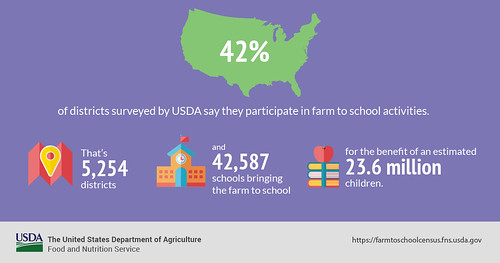
March is National Nutrition Month. Throughout the month, USDA will be highlighting results of our efforts to improve access to safe, healthy food for all Americans and supporting the health of our next generation.
We’ve talked quite a bit in the past about the major benefits we’re seeing in schools and districts that have established a farm to school program. Their efforts are giving students a deep understanding and appreciation for where their food comes from and drastically shifting kids’ opinions of fruits and veggies.
The final results of the USDA Farm to School Census 2015 shed light on another huge benefit of farm to school – we’re talking $789 million huge. That’s the total amount schools report investing in their communities in school year 2013 – 2014 by purchasing local food from farmers, ranchers, fisherman, food processors, and manufacturers. This represents a 105 percent increase over school year 2011 – 2012, when the first USDA Farm to School Census was conducted. In addition, nearly half (47 percent) of districts engaged in farm to school report that they plan to purchase more local foods in the coming years.
These funds are a major boost to local communities, helping sustain local food systems by providing a consistent, reliable customer base. With farm to school, “you have a customer, an able buyer willing to pay fair market price and buy in bulk,” explained Chuck McCool of McCool Farms in Arkansas. As Chuck puts it, “Farm to school is the greatest thing that’s happened to vegetable farmers since… well since I can’t remember when! I can’t remember what would have been better than farm to school… It’s a win-win for everybody.”
But the benefits aren’t just limited to vegetable farmers; farm to school programs present economic opportunities for the whole agricultural industry. Fruits, vegetables and milk top the list of foods schools are most likely to buy locally, but schools indicate that they’d like to also buy more plant-based proteins, grains, meats, poultry and eggs from local suppliers in the future. And these types of programs aren’t only seen in states known for their agriculture like Iowa or Nebraska. The Census results show that farm to school programs are present in every state across the country, in schools large and small, rural and urban.
We’ve recognized a few of these programs on our Farm to School Census page, highlighting three programs per state that are beating their state’s average spending on local foods. But we know there are many more schools out there that are doing innovative work through their farm to school programs. That’s why we’re inviting you to vote for the farm to school program that you think is ‘One in a Melon!’ Now through April 15 you can nominate a school that you believe has an exemplary farm to school program. So check out the extended results of the Farm to School Census and cast your vote today! Winners will be announced this May.
